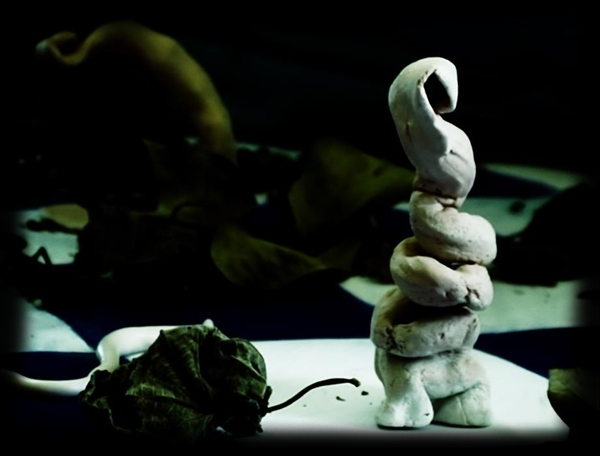Reptilica
Reptilica

Reptilica is partly animation and partly a film where real people perform. It Starts with a doll which is animated with the stop motion technique, she is searching through the many dry leaves that rest on the floor, something she has seen or felt passing by, but she can’t seem to find it.
Other scenes in the movie introduce small pink worms falling on a group of ivy leaves, these are the disturbing presence that bother the doll as they sneak under the leaves, never letting themselves to be seen.
These worms might be imaginary creatures belonging to the same fragmented body of the doll/woman.
The doll’s actions alternate with those of a real woman, which is also searching through the leaves, and her movements at some stage of the film become frenetic: she tries to cover her body with the plants as if to operate an impossible symbiosis with nature.
Reptilica
A Film by Barbara Agreste
To bring Reptilica into being, Barbara Agreste adopted a characteristically hands-on approach to both construction and cinematography. Renting a digital video camera, she built a makeshift set from humble materials — a wooden frame approximately one meter long and eighty centimeters high, enclosed with plywood sheets and crowned with a hand-painted paper floor, composed in multifaceted geometries. This became the uncanny stage where Reptilica was born.
Working with “Fimo” plasticine, Agreste sculpted an assortment of worms, their forms both whimsical and grotesque. The miniature world was further populated with dried leaves, scattered seeds, and desiccated flowers, transforming the enclosed set into a sinister and surreal microcosm — an organic terrarium imbued with decay, transformation, and dream logic.
Reptilica resonates strongly with Agreste’s earlier stop-motion piece, The Tower Trilogy. The visual language is extended rather than reinvented: the same checkerboard floor returns like a haunting refrain, and familiar sculptural motifs — chess-like objects molded in plaster — echo past compositions. But if The Tower Trilogy established the language of threat and claustrophobia, Reptilica deepens it, intensifying the psychological atmosphere with silent, creeping insects and ambiguous life forms that slither and glide across the stage as if drawn by some invisible command.
The presence of the doll — a recurring figure in Agreste’s iconography — also undergoes a transformation. Where The Tower Trilogy introduced a spinning infant’s head on the checkered floor, Reptilica offers a new protagonist: a female doll, sculpted with elegant detail, whose silent gestures reveal a disturbing agency. She watches, stalks, and attempts to seize the serpentine creatures that populate her world — becoming both observer and participant in a realm governed by primal forces.
Yet Reptilica does not remain confined to the claustrophobic box. In a surprising expansion of space, the film opens onto scenes of a river — a liminal zone between inner turmoil and outer purification. Here, the doll sits contemplatively, observing strange, possibly sentient forms — are they objects, organisms, or extensions of herself? These sequences introduce a motif of metamorphosis and release, a tentative dialogue between the self and the natural world, between decay and renewal.
Shot originally on a digital video camera, Reptilica has since undergone a meticulous remastering process. Color grading and image restoration have brought new clarity and depth to its already rich visual textures. The film has recently been transferred to 35mm — a gesture that not only preserves its tactile intensity but also situates it within a tradition of material cinema that Agreste so viscerally evokes.
At once miniature and monumental, Reptilica is a meditation on entrapment, transformation, and the porous boundaries between the organic and the artificial. Like a fever dream conjured from forgotten myths, it confronts us with the beauty and terror of metamorphosis — and the flickering line between predator and prey, self and shadow, inner space and outer purification.